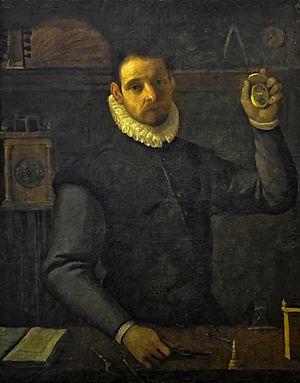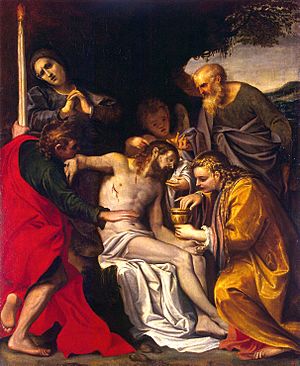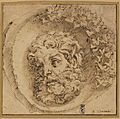Agostino Carracci facts for kids
Agostino Carracci (born August 16, 1557 – died March 22, 1602) was an Italian painter, printmaker, and art teacher. He also designed tapestries. Agostino was a very important artist, working with his brother, Annibale Carracci, and his cousin, Ludovico Carracci. Together, they started an art school in Bologna called the Accademia degli Incamminati. This school taught artists to draw from real life. It helped new art styles grow and moved away from the "Mannerist" style, which sometimes made bodies and spaces look a bit strange. Their school helped painters from the School of Bologna become famous.
Contents
Life of Agostino Carracci
Agostino Carracci was born in Bologna. His father was a tailor. He was the older brother of Annibale Carracci and the cousin of Ludovico Carracci.
Agostino first trained to be a goldsmith. Later, he studied painting. His first teacher was Prospero Fontana. He also learned from Bartolomeo Passarotti. Agostino traveled to Parma to study the paintings of Correggio. He also spent a lot of time in Venice with his brother Annibale. There, he learned how to make engravings from a famous artist named Cornelis Cort.
Starting in 1574, Agostino made many engravings. He copied artworks by famous artists from the 1500s. These included Federico Barocci, Tintoretto, Veronese, and Correggio. He also created some of his own original prints.
Agostino traveled to Venice (in 1582, and again from 1587–1589) and Parma (1586–1587). He worked with Annibale and Ludovico on big fresco paintings in Bologna. These included paintings at Palazzo Fava (showing stories of Jason and Medea, 1584) and Palazzo Magnani (showing stories of Romulus, 1590–1592).
In 1592, he painted The Communion of St. Jerome. This painting is now in the Pinacoteca di Bologna and is seen as one of his best works. In 1586, he painted an altarpiece called Madonna with Child and Saints. This painting is in the National Gallery of Parma.
In 1598, Carracci joined his brother Annibale in Rome. They worked together to decorate the Gallery in Palazzo Farnese. From 1598 to 1600, he painted a triple Portrait, which is now in Naples. This painting shows everyday life. In 1600, Duke Ranuccio I Farnese asked him to come to Parma. He started decorating the Palazzo del Giardino, but he passed away before finishing it.
Agostino's son, Antonio Carracci, also became a painter.
An engraving by Agostino Carracci inspired a famous painting by Matisse called Le bonheur de vivre (Joy of Life).
Famous Works
Most of these are oil paintings on canvas, unless noted otherwise.
- 1573 – Pietà (Muscarelle Museum of Art, Williamsburg, Virginia)
- 1586 – Madonna and Child with Saints (Galleria nazionale di Parma)
- Around 1586 – Lamentation or Pietà (Hermitage, St. Petersburg)
- Around 1589–1595 – Reciprico Amore (an engraving, Baltimore Museum of Art)
- Around 1590 – Annunciation (Musée du Louvre, Paris)
- 1590–1595 – Portrait of a Woman as Judith (in a private collection)
- Around 1592–1593 – Assumption (Ss. Salvatore church, Bologna)
- 1592–1597 – The Last Communion of Saint Jerome (Pinacoteca Nazionale di Bologna)
- Around 1595 – Head of a Faun in a Concave (a drawing, National Gallery of Art, Washington DC)
- 1598–1600 – Triple Portrait of Arrigo, Pietro and Amon (National Museum of Capodimonte, Naples)
Fresco Paintings with Annibale and Ludovico
- Life of Aeneas (Palazzo Fava, Bologna)
- Lives of Jason and Medea (Palazzo Fava, Bologna)
- Scenes from the Foundation of Rome (Palazzo Magnani, Bologna)
- Life of Hercules (Palazzo Sampieri Talon, Bologna)
Images for kids
See Also
 In Spanish: Agostino Carracci para niños
In Spanish: Agostino Carracci para niños






